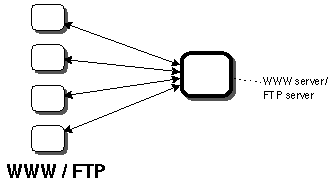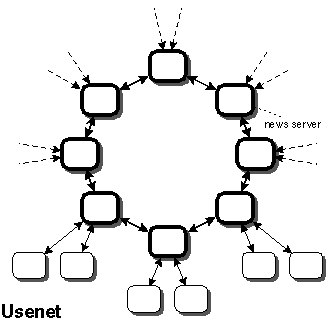
Usenet is a worldwide discussion system distributed mainly (but not exclusively) over the Internet (its formation actually predates the Internet). It consists of thousands of publicly accessible so-called newsgroups each of which deals with a specific topic. Everyone can post messages (or news articles, as they are called) to any of these groups and read what others have posted. Everyone even can - observing certain rules - create a new newsgroup dealing with a new topic.
Newsgroups are hierarchically structured. There are general top-level hierarchies such as comp (for computing), soc (for social) etc. There is a special top-level hierarchy alt (alternative) that is less regulated than the others with respect to creating new newsgroups.
Hierarchy levels are separated by dots. For instance, comp.sys.next.software is a newsgroup that deals with software for the NeXT computer system.
To make sure that only on-topic messages are posted, some newsgroups (by reader decision) are moderated. Messages posted to moderated groups are not directly distributed but automatically emailed to the moderator of the group, who decides if the message will appear in the newsgroup.
If you are new to Usenet, you should read the group news.announce.newusers which contains regular postings with information for new users. Especially important are postings such as A Primer on How to Work With the Usenet Community and Emily Postnews Answers Your Questions on Netiquette that deal with the so-called Netiquette, i.e. common rules about how to communicate with others via Usenet.
Usenet is a service on the Internet, as are Email, FTP or the WWW. However, it has a different communication structure. With Email, two persons communicate privately, just as they would on phone or with regular mail. WWW has a classical vendor-consumer structure: there is one active information vendor who offers on its (public or non-public) website information or services which can be used by passive consumers.
In contrast, Usenet is public and egalitarian. There is no asymmetry between vendors and consumers. Every participant in Usenet is both reader and contributor. In this respect, Usenet, more than the other services, is what the Internet is really about.
In keeping with this spirit of equality and free communication, the software which sustains Usenet is is mostly free software.
The different communication structure of Usenet implies a different technical realization. Email and WWW/FTP both have a point-to- point structure. For Email, the Internet simply connects two computers:

Similarly, with WWW or FTP, many computers connect to one central computer - the (WWW / FTP) server - with a point-to-point connection each:

This centralized model makes no sense for Usenet, where hundreds of thousands of messages per day are posted from all parts of the world and read in all parts of the world. A message posted from someone in New York should be accessible directly in New York for all those people in New York who want to read it. Therefore, Usenet is realized as a worldwide net of news servers which distribute the news messages among each other:

(Note that this diagram is schematic and news servers are actually connected with several other news servers in an arbitrary way, not in a cyclic structure.)
Someone wishing to post a message to Usenet connects with a news server close to her. This news server receives the article and labels it with a message ID that is guaranteed to be unique on the whole Usenet (by combining the (unique) Internet address of the news server with a character sequence that the news server makes sure is locally unique). Then the news server propagates the message to news servers in its neighborhood, which propagate them to still more news servers, etc. In this way, within hours the message is spread worldwide and can be read on all news servers.
To prevent the message from being sent to news servers where it's already stored, each news server enters its name in the Path: header of the message; a news server won't propagate a message to another news server whose name is already included in the Path: header of the message.
The software you use on your own computer to connect to a news server near you and to read and post news messages is called a newsreader. As long as your own computer is permanently connected to a local network that contains a news server, this is no problem. However, if you have to connect to a news server of an Internet service provider over a phone line, you can only read or post news messages as long as you're online. Besides, because of the sheer number of newsgroups and messages, an Internet service provider, who has to carry all newsgroups on its server, may possibly store messages no longer than three or four days - maybe too short a time for you to read all those you're interested in.
This is where PersonalINN comes in. It is a full-fledged news server for your own computer. When you connect to the Internet, it will automatically exchange new news articles in all newsgroups you're interested in with the news server of your Internet service provider and will store the incoming articles on your local computer for as long as you want. There, you (and everyone else on your local computer or network) can read them with a newsreader of your/her choice, and post articles yourself, without a connection to the Internet.